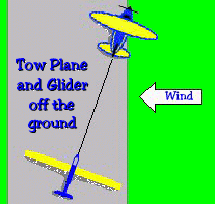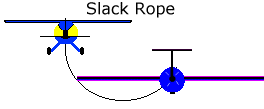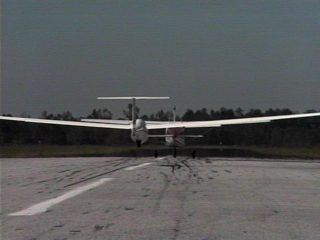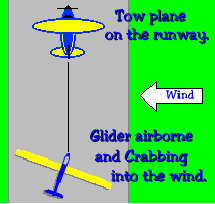Advance the throttle smoothly and quickly, in one motion. If the tow plane is allowed to accelerate and then slow, the glider may overrun the tow line. This may result in the tow line becoming tangled in the landing gear of the glider. The glider may then be unable to release. Accelerate to liftoff speed. During the takeoff phase of flight, ground effect produces some important relationships. The tow plane leaving ground effect will:
- Require an increase in the angle of attack to maintain the same lift coefficient;
- Experience an increase in induced drag and thrust required;
- Experience a decrease in stability and a nose-up change in moment; and
- Produce a reduction in static source pressure and increase in indicated airspeed.
These general effects should point out the possible danger in attempting takeoff prior to achieving the recommended lift-off speed. Due to the reduced drag in ground effect, the tow plane may seem capable of takeoff well below the recommended speed. Lifting out of ground effect with a lower than normal lift-off speed may result in very marginal initial climb performance.
The Glider will normally liftoff first. The pilot of the glider should correct for crosswind until the tow plane becomes airborne.
At this point, the tow pilot must remain extra alert. The tail of the tow plane may be lifted if the glider climbs too high. Should this happen, the application of full-up elevator on the tow plane may not be sufficient to prevent an accident. The tow pilot must be ready to pull the release handle, releasing the glider and regaining control. As a rule of thumb, the use of a 200-ft tow line would require the glider to climb to over 20 feet above the altitude of the tow plane to present a danger of upset.
After liftoff a constant airspeed climb should be established. The pilot of the glider should establish a position directly behind the tow plane. The pilot of the tow plane should maintain a constant ground track on the initial climb. Upon reaching a safe altitude, a turn may be established to maintain the desired departure path. Bank angles should be limited to a maximum of 15-20 degrees.

Climb at full throttle unless otherwise required by the Pilot Operating Handbook. The fuel/air mixture should be leaned only in accordance with the POH for maximum power. Each specific model of glider has a published maximum aero tow speed. The tow pilot must be familiar with this speed, which may be very close to the minimum safe speed of the tow plane.
| Maximum Aero Tow Speed | MPH | Knots |
|---|---|---|
| Blanik L-23 | 93 | 81 |
| Blanik L-13 | 87 | 76 |
| SGS 2-33 | 98 | 85 |
| SGS 1-26 | 95 | 83 |
| ASK 21 | 108 | 94 |
The tow pilot should understand that these are maximum airspeeds. Plan to fly at a speed slower than the maximum while maintaining safe tow plane flying speed. When towing a different model of glider for the first time, obtain a briefing from the glider pilot to ensure compliance with maximum operating speeds. Also note fiberglass gliders like the ASK-21 are towed faster than other popular training gliders.
Recommended towing speed is determined by considering stall speed and maximum aero tow speed of the glider, minimum speed for proper engine cooling of the tow plane, and stall speed of the tow plane. Generally speaking, aero tow should be conducted at the slowest speed possible considering these factors and safety. Speed should be at least 30% above stall speed of the glider and 20% above the stall speed of the tow plane.
Because of the potential for low altitude emergencies, the initial departure path must remain upwind and within gliding distance of the airport. If circumstances do not permit an upwind departure, plan the climb to remain in a position that will allow the glider to return to the traffic pattern with the existing headwind component.
When towing anticipate maneuvers, such as “Boxing The Wake”.

A thoughtful CFIG or glider pilot will communicate the intention to maneuver behind the tow plane. However, the tow pilot should remain alert for unannounced maneuvering. Glider pilot’s normally begin the “Box The Wake” maneuver by descending vertically from high tow position to low tow position. Once a similar maneuver is detected, maintain a constant heading and a wings level attitude. After the “Box The Wake” maneuver is completed and the glider is stabilized in the high tow position you can resume turns.

Slack Rope
During tow the instructor may demonstrate and practice slack rope recovery procedures. This maneuver normally involves a climb to one side or the other followed by a small dive to create the slack in the tow line. The instructor will then have the student take the slack out of the tow line without breaking the rope. Be alert for these manevuers and do not mistake the climb and dive maneuver as a release.




